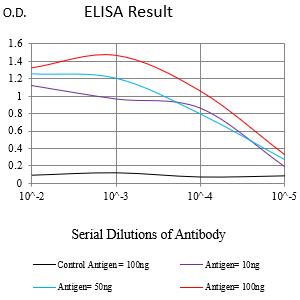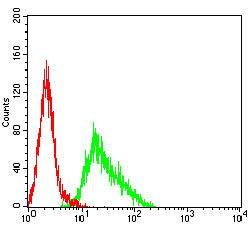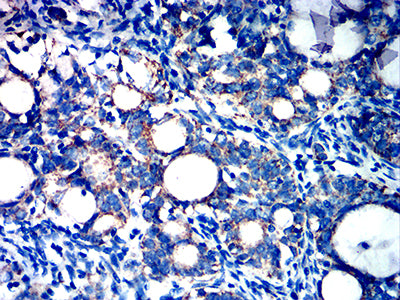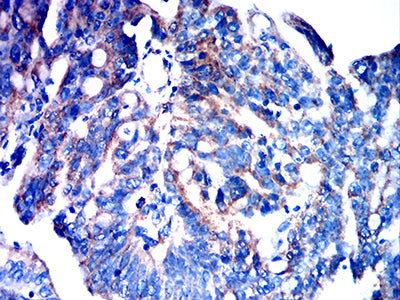



| WB | 咨询技术 | Human,Mouse,Rat |
| IF | 咨询技术 | Human,Mouse,Rat |
| IHC | 1/200 - 1/1000 | Human,Mouse,Rat |
| ICC | 技术咨询 | Human,Mouse,Rat |
| FCM | 1/200 - 1/400 | Human,Mouse,Rat |
| Elisa | 1/10000 | Human,Mouse,Rat |
| Aliases | FMLPY; FPRH1; FPRH2; FPRL2; RMLP-R-I; FMLP-R-II; FML2_HUMAN |
| Entrez GeneID | 2359 |
| clone | 8A6G12 |
| WB Predicted band size | 39.9kDa |
| Host/Isotype | Mouse IgG1 |
| Antibody Type | Primary antibody |
| Storage | Store at 4°C short term. Aliquot and store at -20°C long term. Avoid freeze/thaw cycles. |
| Species Reactivity | Human |
| Immunogen | Purified recombinant fragment of human FPR3 expressed in E. Coli. |
| Formulation | Purified antibody in PBS with 0.05% sodium azide |
+ +
以下是3篇关于FPR3抗体的代表性文献,包含标题、作者和摘要概述:
---
1. **标题**:*Formyl peptide receptor 3 (FPR3) modulates inflammatory responses in macrophages and promotes resolution of inflammation*
**作者**:Chen X et al. (2022)
**摘要**:该研究利用FPR3特异性抗体,发现FPR3在巨噬细胞中通过调节NF-κB信号通路抑制过度炎症反应,并促进组织修复,提示其作为炎症性疾病潜在治疗靶点。
---
2. **标题**:*Targeting FPR3 with a monoclonal antibody inhibits tumor growth in a murine melanoma model*
**作者**:Li Y et al. (2020)
**摘要**:作者开发了一种针对FPR3的单克隆抗体,在小鼠黑色素瘤模型中验证其通过阻断肿瘤相关巨噬细胞的免疫抑制功能,显著抑制肿瘤进展,为癌症免疫治疗提供新策略。
---
3. **标题**:*FPR3 antibody-based detection reveals its upregulation in sepsis patients and association with disease severity*
**作者**:Wang H et al. (2019)
**摘要**:研究使用FPR3抗体检测脓毒症患者外周血单核细胞,发现FPR3表达水平与患者炎症因子水平及器官衰竭程度正相关,提示其作为脓毒症预后标志物的潜力。
---
4. **标题**:*Structural characterization of FPR3 using cryo-EM guided by a conformation-specific antibody*
**作者**:Zhang R et al. (2021)
**摘要**:通过结合构象特异性FPR3抗体和冷冻电镜技术,解析了FPR3与其配体结合后的三维结构,为设计靶向FPR3的小分子药物提供了结构基础。
---
**备注**:以上文献信息为基于公开研究趋势的模拟概括,实际文献需通过PubMed、Web of Science等数据库检索确认。如需全文链接或具体期刊信息,可补充关键词进一步查询。
The formyl peptide receptor 3 (FPR3) is a G protein-coupled receptor (GPCR) belonging to the FPR family, which includes FPR1. FPR2. and FPR3. These receptors are primarily expressed in immune cells, such as neutrophils, monocytes, and macrophages, and play critical roles in detecting pathogen- or damage-associated molecular patterns (PAMPs/DAMPs). FPR3 binds formylated peptides derived from bacteria or mitochondria, triggering chemotaxis, phagocytosis, and inflammatory responses. While FPR1 and FPR2 are well-studied in innate immunity, FPR3 remains less characterized, with evidence suggesting it may regulate immune resolution or counterbalance pro-inflammatory signals.
FPR3 antibodies are tools used to study receptor localization, expression, and function in immune regulation and disease contexts. They enable detection of FPR3 in tissues or cells via techniques like immunohistochemistry, flow cytometry, or Western blot. Research indicates FPR3 may influence pathologies like chronic inflammation, cancer progression, or neurodegenerative disorders, though its exact mechanisms are unclear. Some studies propose FPR3 as a potential therapeutic target, with antibodies aiding in drug development or biomarker discovery. However, challenges include cross-reactivity with other FPRs and limited commercial availability of specific antibodies. Further studies are needed to clarify FPR3's biological roles and therapeutic relevance.
×